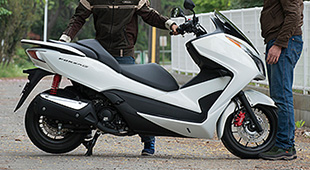Tech Views — Vol.8 CRF1000L Africa Twin
History
Africa Twin History
Honda's first-generation Africa Twin was released in 1988 as a large-displacement touring bike that played a central role in the creation of the Adventure Sports category. At the time, on-road super sports models were rapidly growing in popularity around the world, and the African Twin was conceptually very much the antithesis of those sports machines.
Its design roots could be found in the NXR750, the specially developed Honda Works rally machine that from 1986 took the title in the motorcycle division of the Paris-Dakar Rally (currently 'Dakar Rally') four years in a row in what is to this day regarded to be one of the most severe tests of man and equipment in the world. The technologies developed for this Honda factory racer were fed back directly into the development of the Africa Twin, making it a 'racer replica' of the famed off-road rally machine.
While market interest in large-displacement motorcycles produced in the late 1980s was largely focused on 'racer replica' super sports models, the Africa Twin's positioning as a touring bike with off-road styling was, in a word, unique. Moreover, as most off-road models were powered by small to midsized engines, the Africa Twin's large-displacement V-twin made it singularly extraordinary for its time.

Featuring distinctive off-road styling, the African Twin made its debut with a large-volume fuel tank, dual headlights and large integrated fairing. Its liquid-cooled 4-stroke 52° V-twin engine featured Honda's unique offset dual-pin crankshaft for smooth operation, a 3-valve head configuration for enhanced intake and exhaust efficiency, and dual spark plugs for improved combustion efficiency. As a road bike, the Africa Twin's highly reliable power unit also made it an excellent touring model for its time.
The African Twin's chassis was constructed on a highly rigid box-section double-cradle frame, and featured a large-volume 24-liter fuel tank that integrated in form with its wide-coverage fairing. Fitting an off-road styled model with such a large fairing gave this 'Paris-Dakar Replica' the look of the actual machines that had recently conquered the Paris-Dakar Rally. Further equipping it with dual headlights and a large aluminum engine bash plate, not to mention wide-coverage knuckleguards, rugged front fork bottom case covers and a spacious buckskin-textured seat, gave birth to a new Rally Replica genre of Dual Sport motorcycles that had never existed before.
In 1990, the Africa Twin's displacement was increased from 647cc to 742cc. It was also given a larger and taller windscreen, a larger-capacity battery, and brighter headlights, which further augmented its broad appeal as a full-scale Adventure Sports model. 1992 saw the adoption of a multi-function digital trip meter, which provided not only dual odometers and a trip countdown display function, but also a stopwatch. A full model change in 1993 further raised the Africa Twin's level of refinement, and extended its popularity as a full-sized Adventure Sports model well beyond the end of its production run in 2003.









